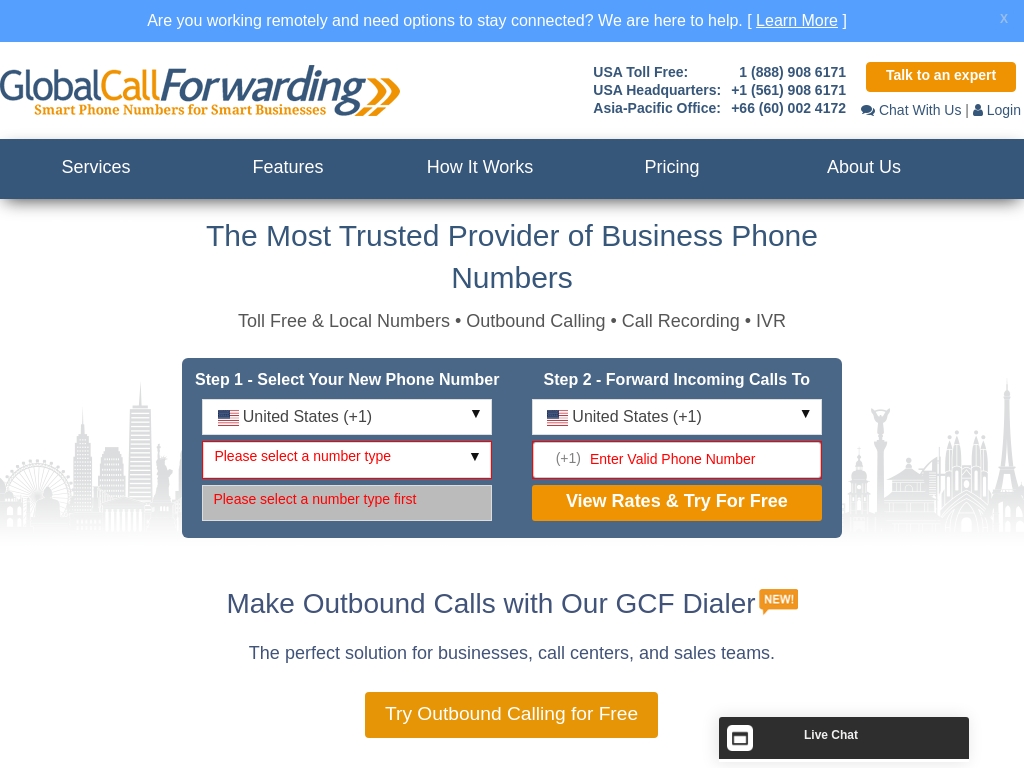
3 Telecommunications Business Success Stories [2025]
The telecommunication business involves the development, ownership, or operation of one or more telephone, telecommunications or information systems. Typically, telecom companies provide infrastructure to enable clients to transmit voice, video, and data.
To start a telecommunication business, you need telecommunication skills.
In this list, you'll find real-world telecommunications business success stories and very profitable examples of starting a telecommunications business that makes money.
1. United World Telecom dba Global Call Forwarding ($10.1M/year)
Thierry Genoyer, founder and CEO of United World Telecom, came up with the idea for his virtual phone numbers business after reading about the "international callback industry" in the Wall Street Journal. With his international background and trilingual abilities, Genoyer saw an opportunity to enter a fast-growing segment with low barriers to entry. After purchasing equipment and building his own invoicing system, he launched the business and attracted customers through online forums, international publications, and cold calling. Today, United World Telecom serves over 2,000 business customers worldwide and remains profitable.
How much money it makes: $10.1M/year
How many people on the team: 32


United World Telecoms' founder saw explosive growth potential in the international callback industry and has since created a virtual phone system, partnered with over 2000 businesses worldwide, and uses Google Ads, SEO, and email marketing to promote customer satisfaction.




2. Tesix Wireless Network ($5.16M/year)
Chaymeriyia Moncrief, the founder of Tesix Wireless Network, came up with the idea for her prepaid wireless carrier after experiencing frustration with high phone bills and fees from traditional contract carriers. She realized that there was a need for a carrier that catered to young adults and millennials who wanted lower-cost phone services without contracts or data limits. Through extensive research and learning about MVNOs, she discovered a way to launch her own carrier without requiring millions of dollars and towers in every state. After 412 days of planning and preparation, Tesix Wireless Network was successfully launched, attracting thousands of subscribers and generating significant monthly revenue.
How much money it makes: $5.16M/year
How much did it cost to start: $125K
How many people on the team: 8


This case study is about how Chaymeriyia Moncrief launched Tesix Wireless Network, a prepaid wireless carrier with around 7,000 mobile subscribers and an average monthly revenue of $430,000 from mobile subscriptions, box sells, and activations kits, targeting young adults and millennials who want lower phone services, zero fees, no contracts, and zero limits on their data by leveraging influencers, raising funds, and building an online presence.




3. KelTech IoE ($1.8M/year)
Mark Kellett, founder of KelTech IoT, came up with the idea for his business after experiencing the challenges of building advanced Telecoms and Energy Networks. He saw that the existing approaches were leading to a growth in energy and resource consumption, which inspired him to create more efficient and sustainable solutions. The company has already won accolades, including coming 1st out of 800 entrants in a Global Utility Start-up competition and being asked by Amazon to showcase their solution at the finals of their Clean Energy Accelerator.
How much money it makes: $1.8M/year
How much did it cost to start: $2M
How many people on the team: 12


KelTech IoT founder Mark Kellett shares insights on building a next-generation energy and infrastructure company bridging the energy and telecoms gap by creating more efficient and sustainable solutions as network demands increase in the age of IoT, with projected revenues expected to be greater than $100M after 5 years.





Download the report and join our email newsletter packed with business ideas and money-making opportunities, backed by real-life case studies.

Download the report and join our email newsletter packed with business ideas and money-making opportunities, backed by real-life case studies.

Download the report and join our email newsletter packed with business ideas and money-making opportunities, backed by real-life case studies.

Download the report and join our email newsletter packed with business ideas and money-making opportunities, backed by real-life case studies.

Download the report and join our email newsletter packed with business ideas and money-making opportunities, backed by real-life case studies.

Download the report and join our email newsletter packed with business ideas and money-making opportunities, backed by real-life case studies.

Download the report and join our email newsletter packed with business ideas and money-making opportunities, backed by real-life case studies.

Download the report and join our email newsletter packed with business ideas and money-making opportunities, backed by real-life case studies.










